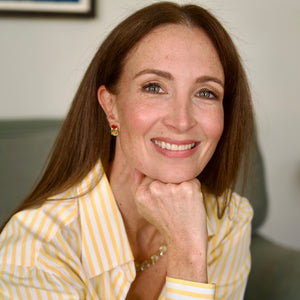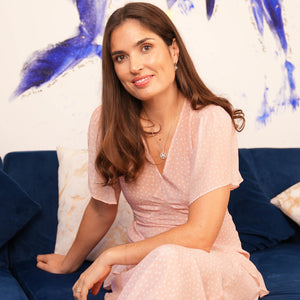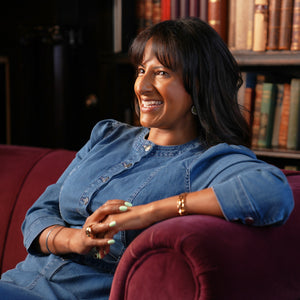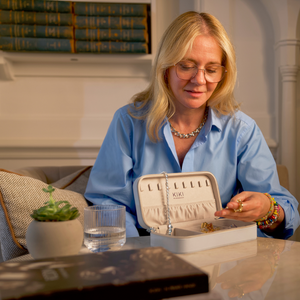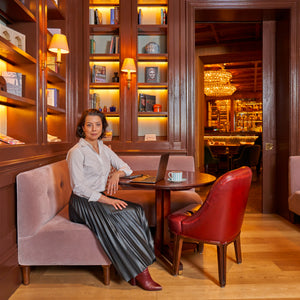Kiki's Woman of the Month is the amazing Kirsty Murphy.
Kirsty Murphy made history as the 1st (and so far only) female pilot in the Royal Air Force Aerobatic Team, The Red Arrows. However, with a 17 year fast jet career under her belt, this is only part of the story. She has flown 39 operational missions over Iraq in the Tornado GR4 and instructed a high proportion of the current generation of frontline fast jet pilots. Now a pilot with civilian aerobatic display team, The Blades, she demonstrates her flying skills at airshows around the world as well as sharing her love of flying providing civilian passengers the 'airline flight of their life!'

How did your interest in flying develop?
When I was younger my dad was in the Royal Air Force. He was a navigator on one of the fast jet squadrons. During the summer holidays I used to spend time on the squadron with him - helping to plan the missions, going into the air traffic control tower (and sometimes I even spoke to him on the radio); watching the aircraft land and joining in with the debrief. The other members on the squadron were all males in those days but they really made me feel part of their family. I was 13 and it was at that point that I realised I wanted to have a job that replicated that same sense of belonging and teamwork. I was in awe of the way they could be joking around one minute, having a bit of fun and then quickly change the focus to be very professional. I feel lucky that I got to experience being on a squadron first hand, at that age, since it definitely shaped my ambition to be a pilot.

What were your biggest career challenges?
The biggest challenges I've had in my career are linked to mental health issues. When I was on the Red Arrows there were two completely independent accidents that resulted in two fatalities. These were people who I had worked with for a long time and had friendships with. It was a really challenging time to have to get on with being a Red Arrows pilot whilst dealing with what had happened, and it was something I really struggled with. I continued as much as I could and then realised, I needed to stop and do the unthinkable - stop being a Red Arrows pilot.
I had to come to terms and deal with that side of my health, which I did. It has given me great strength moving forward in my life in terms of how I now approach my life and challenges that I face. How you think about an event can change your perception and the subsequently your behaviours, which in turn changes how you think about the event, and so the cycle continues. This can be a positive cycle or an unhelpful cycle. If youactively change how you think about something that will change how you feel, and that will change how you behave. It’s not easy and it takes practice but I have taken a lot from that period; it was a very difficult timeto get through but I try and take the positives from that and learn from it.

Who were/are your role models?
One of my role models is Michelle Obama. I found her book ‘Becoming’ really inspiring and a lot of what she talks about is relatable to encouraging females into the Aviation Industry - it's all about gettingyoung women to the door, creating awareness, and building confidence to go for those opportunities that they otherwise wouldn't consider. Michelle Obama discusses diversity with a point of view I hadn’t thought about before and I have found that it has changed my approach to my outreach work. I am aware that I am a role model for young women and I do a lot of outreach work. This book was an eye-opener, and really changed my outlook.

What do you think could be done to encourage more women into the industry?
I do think there is a disappointing number of females throughout the aviation industry, not just in aircrew. Its a really complex problem thoughsince the inequality exists for lots of different factors. I personally don't agree with quotas, so I don't like the idea of any company needing to recruit a certain percentage of females but what I think is really important is to get females to the door in the first place. If they're good enough then that's fine and then they can be recruited. So for me it's about role models getting out there and showing young girls that aviation is an option. It’s not for everybody but it's an option that they should considerrather just dismiss straight away because it’s ‘for men’. Secondly, I think there is a responsibility on companies to get out there and really proactively encourage young women to the door - to the interview point -and then from that point onwards it has to be absolutely fair playing field.

What is next in your career?
It's difficult to know what's going to come next in my career. I've been so lucky so far; I had an amazing 17 years in the Air Force, but I did very different roles. I was an instructor pilot; I was on the frontline on the tornado GR4 and I was also a Red Arrows pilot so those three roles were so different and I got real satisfaction from each of them for very different reasons. When I left the Air Force and joined a civilian flying company, flying for the Blades Aerobatics Team – it was similar to the Red Arrows role; but different because it's in a civilian environment and I get to fly passengers. I love that I get to share my love of flying with people who have never done that kind of aerobatics before! I've always liked a sense of security about my life (especially after 17 years in the military!) butduring COVID, the last couple of years has really taught me that I can actually be a bit braver and a bit bolder than that now. So I don't mind that I'm not quite sure what next year holds or year after that. I'm not 100% sure where my future is headed; but that doesn't bother me - I'm quite excited to find out!





